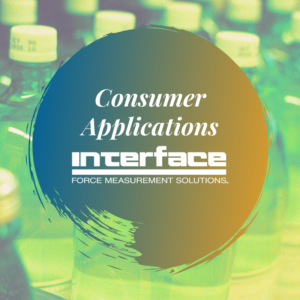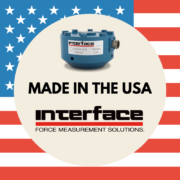Load Cells for Consumer Product Applications
 Typically, when engineers talk about load cells and their multitude of uses, it is assumed the applications are large-scale industrial projects like airplanes, rockets, and automobiles. However, did you know Interface load cells are regularly used for research and development (R&D), manufacturing, and end-of-line testing for countless consumer products?
Typically, when engineers talk about load cells and their multitude of uses, it is assumed the applications are large-scale industrial projects like airplanes, rockets, and automobiles. However, did you know Interface load cells are regularly used for research and development (R&D), manufacturing, and end-of-line testing for countless consumer products?
Force is one of the most critical pieces of measurement in product development. This is especially true for consumer products that we interact with every day. Load cells are the tools that ensure products feel, handle and react the way they should in a consumer’s hand.
Here are a few examples showcasing how load cells touch almost everything the consumer touches.
A perfect example of a consumer product where force measurement plays a critical role in human interaction is in the abundance of numerous touch screens. Load cells are used in the R&D process to measure the accuracy, pressure, and sensitivity of the touch screen consumer interacts with on a minute-by-minute basis. The little things we don’t think about when using a tablet or smartphone, such as the smooth feeling of scrolling through social media pages, is possible because of testing using a load cell.
Another common consumer application type of load cells being used to improve product feedback and interaction is with simulation programs. High-end flight simulators often use load cells to measure the force of haptic feedback on the joysticks or chair when interacting with a flight simulator. The feeling of drag or rough winds a pilot experiences in a simulation is measured and refined for accuracy using a load cell.
Load cells are also an integral part of the manufacturing process for consumer goods. If you’ve ever seen a piece of candy with a logo stamped on it, chances are high a load cell was involved in determining the level of force to apply an exact brand stamp. Load cells are used on the stamping machine to ensure the right amount of force is used to apply the logo without crushing the candy.
In the food and drug industries, load cells are used in manufacturing facilities and on a wide variety of packaging machines. They are used for ultrasonic welding, which is the sealing process for plastic, paper or fabric shopping bags, garbage bags, and diapers. Potato chip assembly lines use load cells to weigh the bags as they fill them with chips to know when to stop and move on to the next bag. And the same stamping process used for candy in applying labels is used on pills.
Companies also incorporate load cells in end-of-line product testing. Furniture often goes through rigorous testing to ensure reliability. The furniture has various loads applied to it to confirm it can hold heavier weights over time, the furniture can also be bent and flexed to check the quality of the materials. To reduce waste and ensure product quality, many consumer bottles use a torque transducer for end-of-line testing to test the proper cap implementation.
Batteries are another consumer product that goes through R&D and end of line testing to measure the force needed to damage the casing. This is used to eliminate poorly designed and assembled batteries, as the acid inside can do immense harm if a child or adult is able to accidentally crush one.
Force measurement is also something that plays a role directly in the products we use. For instance, scales we use to weigh ourselves, food, and more, have load cells in them. Racecar gaming brake pedals are another example. High-end racing simulators need their brake pedal to be very accurate at measuring the amount of force applied to it to react as a real car would. Load cells are implemented in the base to provide accurate force readouts to the simulator in real-time.
Most products we all interact with every day have had some force testing or are currently using a sensor to manage its use and reliability. Other consumer products that use Interface load cells, in all capacities and models, include treadmills, skis, bicycles, coffee makers, gaming brake pedals, boats, golf balls, desk drawers, guitars and robotic vacuums. And that is just to name a few.
Load cells and other force measurement tools like torque transducers are an integral part of developing, testing, and manufacturing reliable and accurate consumer goods. Think about this the next time you are handling your smartphone or carrying in groceries from the store. None of it would be possible without the use of force measurement equipment.
Contributor: Kim Williams, Business Development Manager at Interface









